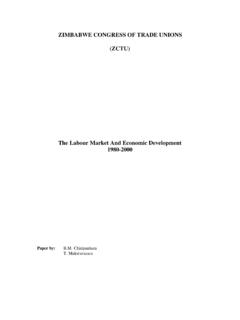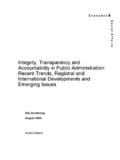Transcription of The Size and Role of Government: Economic Issues
1 CRS Report for CongressPrepared for Members and Committees of Congress The Size and role of government : Economic Issues Marc Labonte Specialist in Macroeconomic Policy June 14, 2010 Congressional Research Service7-5700 RL32162 The Size and role of government : Economic Issues Congressional Research Service Summary The size and role of the government is one of the most fundamental and enduring debates in American politics. Economics can be used to analyze the relative merits of government intervention in the economy in specific areas, but it cannot answer the question of whether there is too much or too little government activity overall. That is not to say that one cannot find many examples of government programs that economists would consider to be a highly inefficient, if not counterproductive, way to achieve policy goals. Reducing inefficient government spending would benefit the economy; however, reducing efficient government spending would harm it, and reducing the size of government could involve either one.
2 government intervention can increase Economic efficiency when market failures or externalities exist. Political choices may lead to second-best Economic outcomes, however, and some argue that, for that reason, market failures can be preferable to government intervention. In the absence of market failures and externalities, there is little Economic justification for government intervention, which lowers efficiency and probably Economic growth. But government intervention is often based on the desire to achieve social goals, such as income redistribution. Economics cannot quantitatively value social goals, although it can often offer suggestions for how to achieve those goals in the least costly way. The government intervenes in the economy in four ways. First, it produces goods and services, such as infrastructure, education, and national defense. Measuring the effects of these goods and services is difficult because they are not bought and sold in markets.
3 Second, it transfers income, both vertically across income levels and horizontally among groups with similar incomes and different characteristics. Third, it taxes to pay for its outlays, which can lower Economic efficiency by distorting behavior. Not all taxes are equally distortionary, however, so there are ways of reducing the costs of taxation without changing the size of government . Furthermore, deficit spending does not allow the government to escape the burden of taxation since deficits impose their own burden. Finally, government regulation alters Economic activity. The Economic effects of regulation are the most difficult to measure, in terms of both costs and benefits, yet they cannot be neglected because they can be interchangeable with taxes or government spending. There are many different ways to measure the size of the government , making its Economic effects difficult to evaluate.
4 Budgeting conventions are partly responsible: tax expenditures, offsetting receipts and collections, and government corporations are all excluded from the budget. But some governmental functions, like regulation, simply cannot be quantified robustly. Discussions about the overall size of government mask significant changes in the composition of government spending over time. Spending has shifted from the federal to the state and local level. Federal production of goods and services has fallen, while federal transfers have grown significantly. In 2009, nearly two-thirds of federal spending is devoted to Social Security, Medicare, Medicaid, and national defense. Thus, there is limited scope to alter the size of government without fundamentally altering these programs. The share of federal spending devoted to the elderly has burgeoned over time, and this trend is forecast to continue. The size of government has increased significantly since the financial crisis of 2008 as a result of the government s unplanned intervention in financial markets and subsequent stimulus legislation.
5 Much of the increase in government spending is temporary and could be reversed when financial conditions return to normal, although many question how easy it will be for the government to extricate itself from new commitments it has made. The Size and role of government : Economic Issues Congressional Research Service Contents How Does the government Affect the Economy?.. 1 How Large Is the government ? ..1 Effect of the government on Economic Efficiency .. 13 What Is a Market Failure? .. 14 Public Goods .. 14 Common Resources .. 15 Monopoly Power .. 15 Externalities ..16 Asymmetric Information .. 17 Failure to Optimize .. 17 How Do Taxes Affect Economic Efficiency?.. 18 Balancing Economic Efficiency With Other 19 Effect of the government on Economic Growth .. 20 Effect of Spending ..21 Effect of 23 Effect of Taxes .. 24 Effect of Regulation ..25 Concluding Remarks .. 26 Figures Figure 1.
6 Federal Outlays and Receipts, 3 Figure 2. Federal Spending by Function, 5 Figure 3. government Purchases and Transfers, 6 Figure 4. Federal and State and Local Outlays, 10 Figure 5. Public Investment Spending, 22 Tables Table 1. Estimated Revenue Loss from Income Tax Expenditures Exceeding $10 Billion in FY2011 .. 7 Table 2. Offsetting Receipts and Collections by Type, 9 Contacts Author Contact Information ..27 27 The Size and role of government : Economic Issues Congressional Research Service 1 he appropriate size and role of the government is one of the most fundamental and enduring debates in American politics. What role does the state play in Economic activity? How is the economy affected by government intervention? Many of the arguments surrounding the proper size of government are Economic in nature, and these are discussed in this report. How Does the government Affect the Economy?
7 government activity affects the economy in four ways: The government produces goods and services, including roads and national defense. Less than half of federal spending is devoted to the production of goods and services. The government transfers income through both the tax system and outlays. Popular perception typically focuses on transfers across income classes through the progressive income tax system and means-tested benefits, referred to as vertical redistribution. But vertical redistribution is dwarfed by horizontal redistribution, transfers unrelated to income class. The largest beneficiaries of transfers are the elderly, through programs such as Social Security. The government collects taxes, and that alters Economic behavior. For instance, taxes on labor change the incentives to work, while taxes on specific goods ( , gasoline) change the incentive to consume and produce those goods.
8 The government regulates Economic activity for a number of reasons, including environmental protection, workplace safety, and consumer protection. The Economic impact of regulation is probably the hardest and most contentious to measure of the four types of government Economic How Large Is the government ? Before assessing how the government affects Economic activity, it is necessary to agree upon how to measure the size of the government . For a number of reasons, this exercise is less straightforward than it may seem. The size of government can be expressed in a number of different units of measurement. Should the size of government be measured in dollars, on a per capita basis, by total employees, or as a percentage of GDP? Each measurement has its advantages, but some measurements have more shortcomings than others. If measured in dollars, then those dollars should be adjusted for inflation.
9 The purpose of measurement is to gauge the resources at the government s disposal, and a dollar of tax revenue in 1946 would buy $11 of goods and services in 2009 because of Measuring the size of 1 The term regulation is used in this report in the popular sense to encompass laws, mandates, and government regulations that affect commerce. 2 Federal Reserve Bank of Minneapolis, What is a Dollar Worth?, T The Size and role of government : Economic Issues Congressional Research Service 2 government by the number of employees is imprecise because the government can substitute capital for labor over time to accomplish the same tasks with fewer employees. For example, the government s purchase of computers has rendered many clerical jobs obsolete. The federal government can also pay workers in the private labor force through contracts and grants or allow state and local government workers to deliver federal programs in place of federal public servants.
10 One estimate puts the number of private and state and local government workers working for the federal government at more than seven times the size of the federal Comparisons over time that do not incorporate demographic change are arguably misleading because government spending per capita is more meaningful than total government spending: $ billion in federal spending in 1946 amounted to $3,242 per person then, but would only finance $1,493 per person in 2009. But over long periods of time, because of the power of compounding, any level of government spending will appear to be insignificant unless it is expressed as a fraction of gross domestic product (GDP) (a measurement that incorporates inflation and population growth). In 1944, at the height of World War II, federal spending was about one-third of today s federal budget in constant (inflation-adjusted) dollars. Yet outlays in 1944 accounted for of GDP, whereas the budget in 2008 accounted for a little more than half that ( of GDP).
















